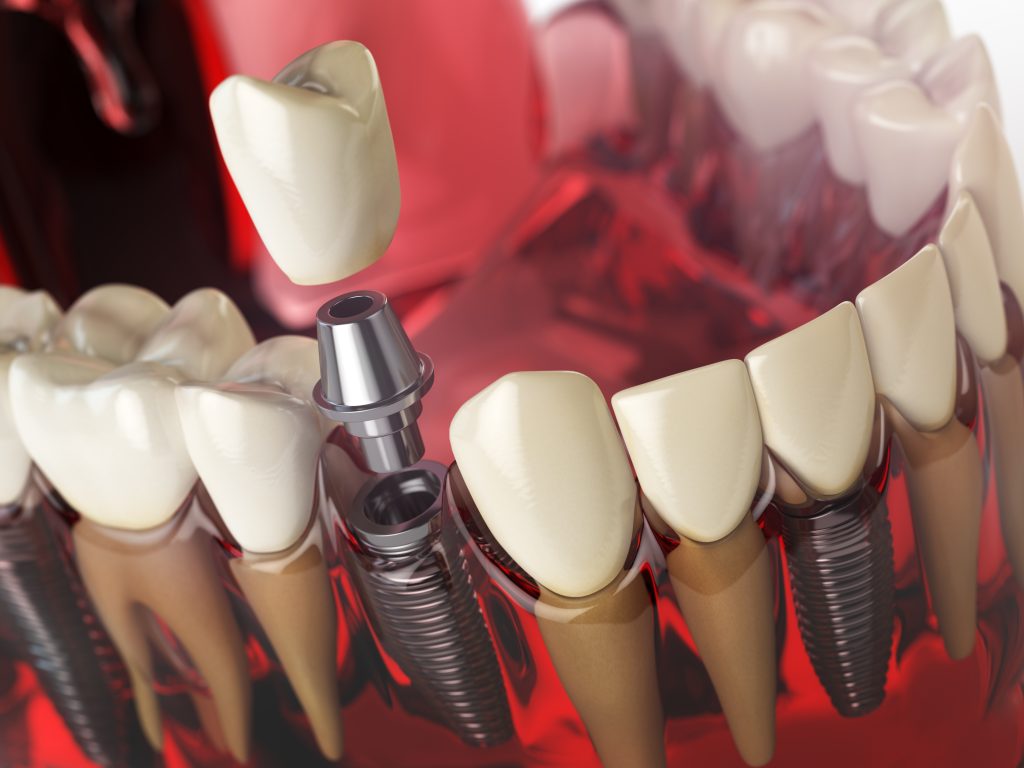Implant Treatment
Implant Treatment
A dental implant is a titanium screw that is placed into the jawbone to replace missing teeth. These screws act as artificial tooth roots and allow us as dentists to design comfortable prostheses for our patients. Crowns, bridges, and other dental prostheses can be placed on top of the implants to fill in the gaps left by missing teeth. Implants can help correct aesthetic, functional, and phonetic (speech) issues caused by tooth loss, and our prostheses can restore our patients' smiles and ability to eat and speak properly.

Who is a candidate for implant treatment?
Implant treatment can be applied to individuals over the age of 18 who have a good general health condition, healthy gums, and sufficient bone mass in their jaw. However, since everyone's oral structure and dental health are different, it is necessary to consult a dentist to determine whether you are a suitable candidate for implant treatment.
What needs to be done before implant treatment?
Before implant treatment, a detailed examination of the patient's oral health is performed and radiographic images are evaluated. After the radiographic examination, measurements are taken to select the appropriate size and diameter of the implant and determine the area where it will be applied. In addition, it is very important for the patient to have good oral hygiene before implant treatment. If necessary, preventive measures such as dental cleaning, treatment of gum disease, and treatment of decayed teeth should be taken to ensure oral hygiene. If the patient has a systemic illness, necessary precautions should be taken in accordance with the instructions of the relevant doctors. With these measures, the patient's general health condition can be improved before implant treatment, and the success of the treatment can be increased.
What to pay attention to after implant treatment?
Although dental implantation may seem like a simple surgery, like any surgical procedure, it requires special care. Your dentist and assistants will give you the necessary advice to avoid pain and discomfort after implant surgery and to have a fast recovery period. The issues that you should pay attention to after implantation are summarized below:
- For the first two days after surgery, applying an ice pack externally to the area where the implant was placed is recommended. This procedure should be applied for 10 minutes and then rested for 5 minutes.
- If a dressing is applied after implant surgery, the dressing should remain in place for 30 minutes. Then the dressing should be removed and nothing else should be placed in its place.
- Do not gargle for one day after implant surgery. Antiseptic gargles can be used afterwards. When gargling, care should be taken not to apply pressure.
- You can brush your teeth 24 hours after implantation. The stitches should not be brushed, but the neighboring teeth can be carefully brushed.
- You can eat and drink after the numbness has passed. Avoid very hard foods and hot foods.
- If there are any medications recommended by your doctor, they should be taken regularly.
- Protein-rich foods should be consumed to speed up the recovery process after implant surgery.
- Consumption of milk and dairy products should be limited during the one-week period until the stitches are removed.
- Avoid contact with hard foods on the area where the implant is placed.
- Avoid strenuous exercises after implant surgery.
Dental implant treatment is a suitable option for individuals with good general health, sufficient gum and jawbone structure to support implants, over the age of 18 with completed facial and jaw development. However, a thorough examination and evaluation of radiological images are necessary before implant treatment.
- Young individuals with incomplete development of their jaw and facial bones
- Individuals who have undergone radiation therapy in their head and neck area
- Individuals with uncontrolled systemic illnesses
- Individuals who are heavy smokers
Placing a dental implant into the jawbone typically takes around 10 minutes. In some suitable patient groups, temporary prostheses can be placed on the same day as the implant surgery. However, in standard procedures, a waiting period of 2 months for implants placed in the lower jaw and 3 months for implants placed in the upper jaw is necessary. In patient groups with insufficient bone support and advanced surgical techniques (such as bone grafting, sinus lifting, etc.), the waiting period can be extended up to 6 months.
Implant Treatment for Single Tooth Loss
Missing teeth are not only a cosmetic problem, but also a significant health concern. However, with the right treatment methods, health and comfort can be restored.
In the past, traditional methods such as crown bridges and dentures were used to treat missing teeth. However, these methods sometimes required the cutting of healthy teeth. Especially in cases of single tooth loss, bridges that would be made by reducing neighboring teeth would solve the problem of missing teeth but cause damage to healthy teeth. Nowadays, dental implants made of titanium are placed inside the jawbone and porcelain crowns are placed on top of them to correct missing teeth without touching adjacent teeth. Implants provide natural chewing, speaking, and appearance by supporting the jawbone. Therefore, dental implants are one of the most accurate treatment methods applied for missing teeth and are important for both aesthetics and health.
Implant Treatment for Multiple Tooth Loss
In cases where many teeth are lost, planning is made according to the extent of toothlessness with implants. Suitable prostheses are prepared over the implanted teeth to solve the problem of missing teeth. In cases where two or more teeth are lost side by side, one implant is placed for each end of the gap and a bridge is made on top of these implants. This method can correct multiple tooth loss with a few implants. Implants provide a chewing function close to natural teeth by supporting the jawbone.
Implant Treatment for Complete Tooth Loss
Individuals may lose all their teeth due to some reasons. In this case, complete tooth loss can be treated with dental implants. Traditional full dentures are uncomfortable in terms of function and can negatively affect a person's nutrition, health, and social life. Full dentures were commonly used in the past to provide aesthetics and speaking function, but they have many disadvantages for patients. They can cause mouth sores, food particles can become stuck underneath them, and they may come loose while eating or speaking. Nowadays, it is possible to make implant-supported fixed prostheses for completely toothless patients thanks to technological advancements.
Between 4 to 8 implants are placed in the jawbone for each jaw, depending on the structure of the jawbone and the shape of the prosthesis. Maximum comfort and aesthetics are achieved with the use of appropriate prostheses. In some cases where a few implants are required, it is possible to make implant-supported removable dentures. In this case, support is obtained from the implants to make the removable dentures more comfortable.
Bone grafts, also known as bone powder, can be obtained through different methods. Bone grafts can be human-sourced, animal-sourced, or synthetic, and can be in the form of powder or blocks. Bone grafts are used when there is insufficient bone support in the area where an implant will be placed. Grafting techniques can vary depending on the amount of bone loss and the planned implant treatment, and the appropriate method is chosen for the individual. In some cases, grafting procedures and implant surgery are performed in the same session, while in other cases, grafts may be applied and the jawbone may be allowed to reach the desired volume and integrate with the tissues before implant placement.






